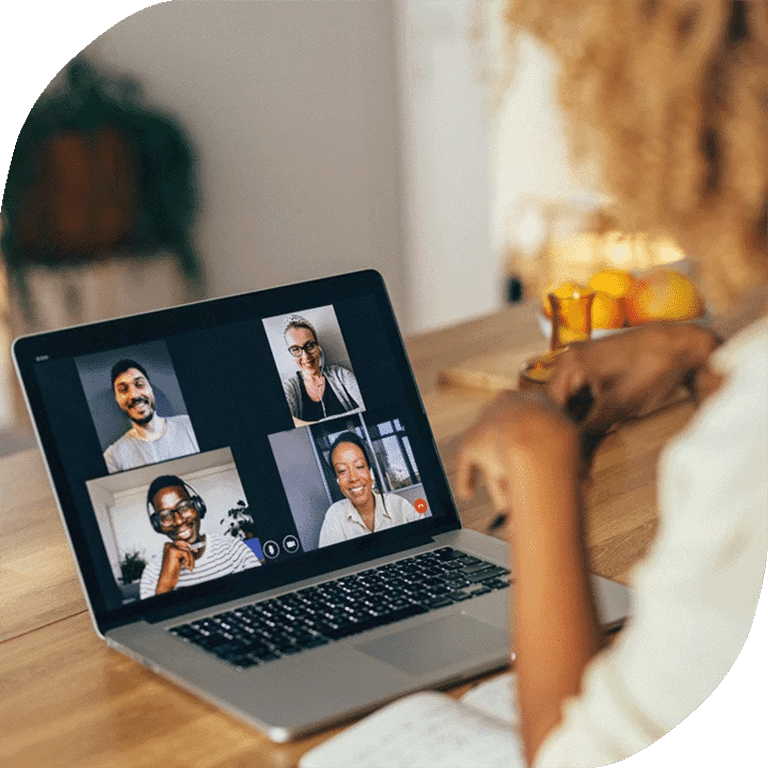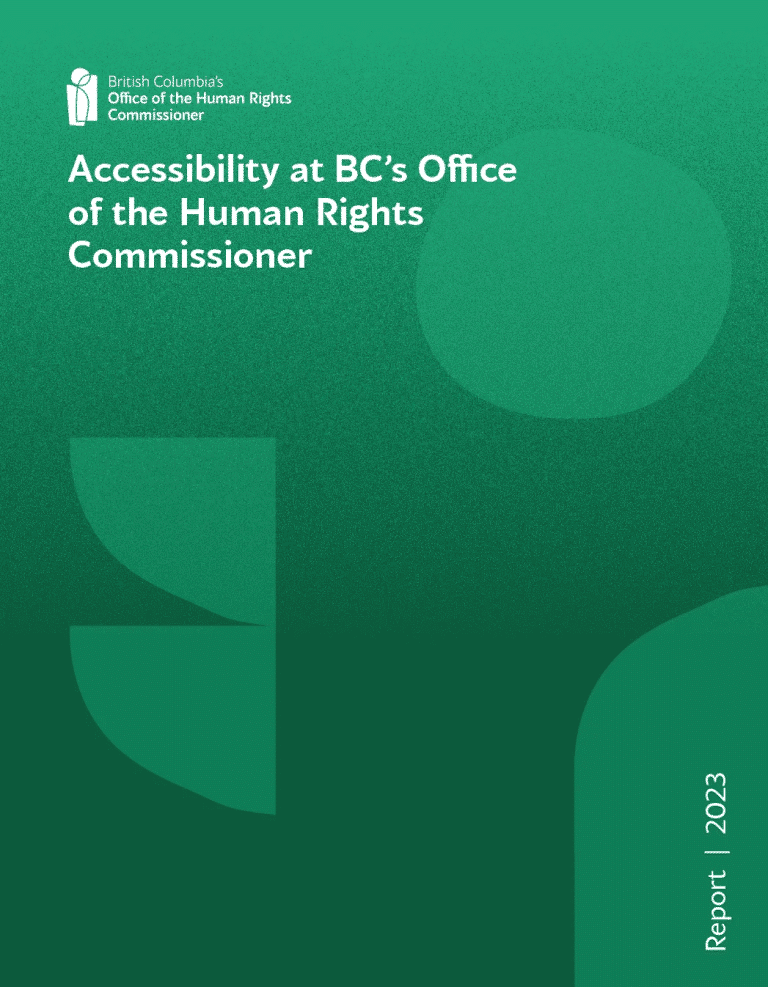This report describes how our Office is taking measures to ensure our information, services and physical and digital spaces are accessible to all people in British Columbia. It is issued in compliance with our obligations under the Accessible British Columbia Act.
Whether internal or external-facing, operational or project-focused, our work is designed for a range of abilities, cultures, languages, education levels, learning styles and viewpoints. Read the report to learn more about our accessibility story and our accessibility plan.
Have feedback for us?
We would appreciate any feedback through our quick poll. All answers are anonymous.
This report is accessible to PDF Universal Accessibility (UA) standards. If you require an alternative format or would like to report errors or give feedback, you can contact BCOHRC at [email protected] or 1-844-922-6472.
The report summary below is also available in:
Different languages
عربى (Arabic) | 简体中文 (Chinese, simplified) | 繁體中文 (Chinese, traditional) | فارسی (Farsi) | Français (French) | हिंदी (Hindi) | 한국어 (Korean) | ਪੰਜਾਬੀ (Punjabi) | Español (Spanish) | Tagalog (Filipino) | Русский (Russian) | Tiếng Việt (Vietnamese)
Audio
American sign language
Summary
Accessibility means making sure that information, activities and spaces can be understood, used and enjoyed by everyone. In British Columbia, a law called the Accessible British Columbia Act helps make sure disabled people are able to access everything they need to be able to participate in society, including by creating some rules that organizations must follow.
To help make sure we follow those rules and become more accessible in general, BC’s Office of the Human Rights Commissioner (BCOHRC) teamed up with other offices like ours to form a Joint Accessibility Committee. Within BCOHRC, we also created an “Accessibility Working Group” made up of staff from different departments and with different life experiences.
Our accessibility story so far
BCOHRC has “guiding principles” that shape how we do our work. Accessibility has always been one of those principles. That is because accessibility is needed to make sure everyone’s human rights can be protected and respected. BCOHRC’s work, then, is created for people with a range of different abilities, cultures, languages, education levels, learning styles and viewpoints.
BCOHRC considers accessibility when doing the following things:
- engaging with people in B.C., including when we host events
- creating learning materials
- designing our office space and rules for the office
- publishing on our website, social media and in reports, studies and other documents
- hiring new people
- working on projects
Joint Accessibility Committee
BCOHRC is part of a Joint Accessibility Committee with other independent offices of the Legislature. The Committee supports each of the member offices in identifying barriers, identifying potential mitigating actions and consulting on each member office’s accessibility plan. Find member offices’ current accessibility plans via their websites:
For example, we provide translation and interpretation into other languages and make sure event spaces are accessible and welcoming to everyone. We design things to make them easier to read and see. We make sure there is space for wheelchairs in our office and that counters and desks can be made higher and lower and have flexible ways of doing things for staff and job candidates with accessibility needs.
In 2022/23, BCOHRC worked with organizations that serve people with disabilities in B.C. to create the #RewriteTheRules campaign. #RewriteTheRules focused on showing how unwritten “rules” make things harder for people with disabilities in big and small ways every day. The campaign invited people to think about how those unwritten rules are bad for all of us and encouraged change.
We are proud of the work we have done around accessibility but we know we need to keep trying to be better.
Building our accessibility plan
To build our accessibility plan, BCOHRC heard from accessibility experts, staff who have worked on disability issues or who have disabilities and people from across B.C.
Our plan is based on principles from the Accessible British Columbia Act, including:
- inclusion (making sure everyone can participate in society)
- adaptability (making sure our plan changes as we learn and grow)
- diversity (understanding that we’re all different and experience the world differently, and that some of us are treated better than others in some areas of life)
- collaboration (working with disabled people and disability organizations)
- self-determination (making sure disabled people can make their own choices)
- Universal Design (meeting the needs of everyone who interacts with us)
We also based our plan on B.C.’s Human Rights Code, which protects groups of people—including people with disabilities—from discrimination in some key areas of daily life.
And we thought about international rights laws like the United Nations Convention on the Rights of Persons with Disabilities. The Convention says that governments should make sure people with disabilities have full access to all services provided to the public.
Our accessibility plan also considers two approaches we take to all our work: a human rights-based approach (HRBA) and a decolonizing approach. The HRBA aims to protect and promote human rights by looking at differences between how groups of people are treated. A decolonizing approach recognises that Indigenous people experience disability differently because of past and current mistreatment and racism.
Where to focus
BCOHRC took a close look at our office space and online content and resources, surveyed our staff and collected feedback from the public. The issues we decided to focus on are:
- how our policies and the way we work make things more difficult for people with disabilities
- how our office spaces, event spaces and other places we work may be difficult to access
- how the way we share information and communicate could be more accessible
- how technology might be difficult for some people to use or access
- how we behave and what we think about different groups of people, including people with disabilities
We grouped those issues into four areas and made a three-year action plan.
The first area is operations. Our priority there is to make sure the way we set up our spaces and buy things is free of accessibility problems.
The second area is public engagement. Our priority is making our learning materials and interactions with people more accessible.
The third area is information and communication. In that area, our priority is to make sure our website and the way we write our documents is accessible.
The fourth area is employment. For employment, we are prioritizing accessible policies and practices for our staff to follow.
Keeping track of progress
We will use BCOHRC’s evaluation framework to see how we are doing at making our spaces, activities and work more accessible. Three of the goals in that framework measure how accessible we are, including being accessible to the people we have relationships with, having accessible learning and guidance resources and having accessible policies.
We will also describe our progress on our three-year action plan by sharing an update in our Office’s annual report every year.
Tell us what you think
Every three years beginning in 2024, BCOHRC will publish a report to share our progress and updates from our accessibility plan. Anyone who would like to give us feedback about our accessibility plan or the accessibility of any of our work is welcome to contact us. They can email our Office at [email protected], leave us a message by calling 1-844-922-6472 or give feedback in the evaluation forms we give out after our events.
- Previous publication:Sparking change: Annual Report 2022/23 and Service Plan 2023/24–2025/26

